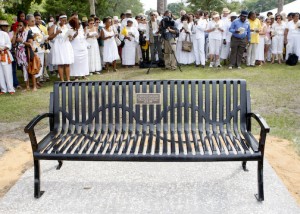In case anyone was paying attention, I wasn’t…
I missed Wednesday, February 17ths doubleheader: the birthdays of Wallace Stegner and Toni Morrison. To miss the birthday of either one is bad. To miss both is deplorable.
My apologies to both.

Toni Morrison’s hometown of Lorain, Ohio is covered in A Journey Through Literary America. An old African proverb, often trotted out, goes: “It takes a village to raise a child.” Hillary Rodham Clinton, our Secretary of State and the wife of the man whom Toni Morrison famously called “the first black president,” even used it as the title of a book. In the case of Toni Morrison, born Chloe Anthony Wofford, the “village” that raised her is the black community in Lorain, Ohio, a steel town on the shores of Lake Erie. With their support and encouragement, she left Lorain after high school for Howard University to make her way in the larger world. “If black people are going to succeed in this culture,” she said in a 1979 interview, “they must always leave. There’s a terrible price to pay.” But, she went on to say, her departure did not take away her power to “savor” that village she left. It is to the environs of Lorain that Morrison returned in her first novel, The Bluest Eye, published in 1970. She has not used the city specifically as a setting in later novels, but she has always returned to it—to the way she saw it in her youth—in order to depict what has been the major focus of her art: the “elaborately socialized world of black people.” In the forty years since the publication of her first novel, Morrison has gone on to become truly one of the lions of American literature. She is a woman with a formidable intellect and gift for storytelling and writing.
Not far from Lorain is Oberlin, Ohio. Oberlin is home to a very well regarded liberal arts college. It was also one of the well-known stops on the Underground Railroad. In honor of that connection, the Toni Morrison Society recently installed a bench there as part of the Bench By the Road Project.

Wallace Stegner’s name has many associations for me. He wrote that a person who has adopted the West as a home must adopt a different aesthetic. I still struggle with the acceptance of that aesthetic even as I admire the beauty of the West. He also owned a home in Greensboro, Vermont (my home state). Of Vermont he famously remarked that it was a state that “has watched humanity go by and has recovered from the visit.” These are but two of the associations. Within the past year, I heard a story on NPR about a typewriter shop in Los Altos where Stegner used to take his manual typewriter to be serviced (he eschewed electric typewriters as being too fast). It is a charming little piece. If you are going to visit that, you should also take a listen (or another listen, if you’ve ever heard it) to Leroy Anderson’s wonderful “Typewriter Song”—another charming evocation of a bygone era. Silicon Valley, the place that made the typewriter a museum piece, surrounds Palo Alto, where Stegner taught at Stanford for many years.
TRH
[i] Profile by Colette Dowling in The New York Times Magazine, May 20, 1979, p. 44